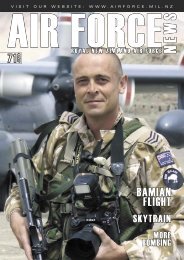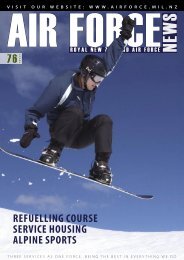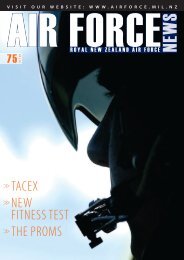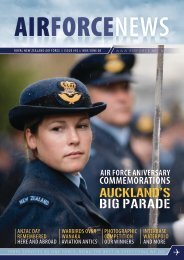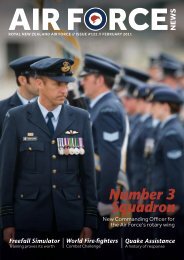February 2007, Issue 78 [pdf 3mb, 44 pages] - Royal New Zealand ...
February 2007, Issue 78 [pdf 3mb, 44 pages] - Royal New Zealand ...
February 2007, Issue 78 [pdf 3mb, 44 pages] - Royal New Zealand ...
Create successful ePaper yourself
Turn your PDF publications into a flip-book with our unique Google optimized e-Paper software.
30<br />
V I T A M I N S A N D M I N E R A L S<br />
‘<br />
As there are very few plant-based sources of this<br />
vitamin, humans generally obtain all of their<br />
vitamin B12 requirements through consumption of<br />
animal foods such as meat and dairy products.<br />
<strong>Zealand</strong> is another risk area. Again this<br />
can be addressed with diet, in particular an<br />
increased intake of low fat dairy products<br />
and ensuring adequate vitamin D status<br />
(sun exposure – not sun burn).<br />
An interesting case of a potential dietary<br />
deficiency in <strong>New</strong> <strong>Zealand</strong> is selenium.<br />
<strong>New</strong> <strong>Zealand</strong> soil is very low in this<br />
mineral which has important antioxidant<br />
properties. This means that most food<br />
grown and produced here is low in this<br />
mineral. Even so, no obvious deficiency<br />
disorder has become apparent, which may<br />
be testament to the body’s ability to adapt<br />
to different environments. Foods that are<br />
higher in selenium include seafood, poultry<br />
and eggs, so a varied diet that includes<br />
regular consumption of these foods should<br />
help ensure that you get enough.<br />
As I stated earlier, some population<br />
groups may be at risk of a particular<br />
micronutrient deficiency. For example, as<br />
vegans consume no animal products at all,<br />
they are at risk of vitamin B12 deficiency<br />
and will need to supplement with this<br />
nutrient. As there are very few plant-based<br />
sources of this vitamin, humans generally<br />
obtain all of their vitamin B12 requirements<br />
through consumption of animal foods such<br />
as meat and dairy products.<br />
Are any supplements useful?<br />
Interestingly, despite their widespread<br />
use, much of the scientific research<br />
investigating the health benefits of<br />
vitamin and supplement use has provided<br />
conflicting results with little conclusive<br />
evidence that supplements improve health<br />
over and above what is provided by the<br />
diet, particularly in <strong>New</strong> <strong>Zealand</strong>. It is<br />
important to note that the supplements I<br />
am referring to within this article are limited<br />
to vitamin and mineral supplements.<br />
There are literally hundreds of different<br />
nutritional supplement products available<br />
within <strong>New</strong> <strong>Zealand</strong> and some of these,<br />
including other micronutrients, provide<br />
obvious benefit to particular groups; but<br />
that’s a whole different article.<br />
What is fortification?<br />
Fortified foods have had nutrients added<br />
to the product over and above what is<br />
naturally occurring within that food. One<br />
of the oldest examples of food fortification<br />
in <strong>New</strong> <strong>Zealand</strong> is the addition of iodine<br />
to table salt but there are now many foods<br />
available that are fortified and this is often<br />
advertised on the packaging. In general,<br />
the introduction of government policy for<br />
either voluntary or mandatory fortification<br />
of foods has the intention of increasing<br />
the intake of a particular nutrient across<br />
the population. The latest example of<br />
this is the debate for and against the<br />
fortification of bread with folic acid, the<br />
synthetic form of folate. Folate is extremely<br />
important in the prevention of neural tube<br />
defects in babies but also has a role in the<br />
prevention of cardiovascular disease. As<br />
50% of pregnancies within <strong>New</strong> <strong>Zealand</strong><br />
are unplanned many women miss the<br />
opportunity to supplement with folic acid<br />
prior to pregnancy and within the first<br />
trimester when it is most important. The<br />
argument against fortification includes the<br />
removal of your right as a consumer to<br />
choose what you are eating, the potential<br />
for extremely high intakes among some<br />
people which can have adverse effects<br />
and the additional cost to manufacturers<br />
to fortify their products<br />
So what do we do about<br />
micronutrients?<br />
I believe by focusing attention on<br />
micronutrient requirements we are<br />
avoiding <strong>New</strong> <strong>Zealand</strong>er’s more important<br />
nutrition issues. Yes, some possible<br />
deficiencies have been identified within<br />
<strong>New</strong> <strong>Zealand</strong> but these deficiencies can be<br />
improved by addressing diet as a whole.<br />
Alarmingly, 34% of our adult population<br />
are overweight and an additional 20% are<br />
obese, while the highest mortality rates<br />
are caused by cardiovascular disease<br />
and cancer (a combined total of about<br />
60% of all deaths). At least 40% of the<br />
total morbidity and mortality from these<br />
‘lifestyle’ diseases can be attributed to<br />
poor diet and lack of physical activity. By<br />
replacing our intakes of nutrient-poor,<br />
energy-dense foods and drinks with<br />
plenty of vegetables, fruits and wholegrain<br />
cereals, moderate amounts of low fat dairy<br />
foods, lean meat, poultry, fish, legumes<br />
and small amounts of vegetable oils, we<br />
can address both our macronutrient and<br />
micronutrient requirements; avoiding<br />
both morbidity associated with over<br />
consumption of macronutrients and<br />
micronutrient deficiencies. Am I starting<br />
to sound like a broken record?<br />
Unfortunately nutrition education is<br />
only part of the road to improving the<br />
health of <strong>New</strong> <strong>Zealand</strong>ers; the other half<br />
of the equation is creating supportive<br />
environments that allow you to make<br />
positive choices. Perhaps we can start to<br />
think about what we can do to contribute<br />
to this need. I hope I have dispelled some<br />
of the myths regarding supplement use. If<br />
you are interested in obtaining more advice<br />
on vitamin and mineral supplements, or<br />
how to improve your diet to ensure you<br />
are obtaining all of your micronutrient<br />
requirements, I strongly suggest you make<br />
sure the person you are talking to does not<br />
have a financial interest in selling you any<br />
of these products. Dieticians or Nutritionists<br />
are probably your best option.<br />
AFN<strong>78</strong> FEBRUARY 07<br />
’<br />
www.airforce.mil.nz<br />
CDF VISITS<br />
ANTARCTICA<br />
C D F LT G E N J e r r y M a t e p a r a e<br />
accompanied the Prime Minister<br />
Helen Clark, Sir Edmund Hillary, other<br />
dignitaries and media to the Antarctic to<br />
mark the 50th anniversary of Scott Base<br />
on Saturday 20 January.<br />
LTGEN Mateparae gave a speech on<br />
<strong>New</strong> <strong>Zealand</strong> Defence’s 50 years support<br />
of the Antarctic programme.<br />
NZDF personnel were part of a team<br />
that erected the first hut at Scott Base,<br />
officially opened on 20 January 1957.<br />
The Antarctic/NZDF relationship<br />
goes back to 1956 when the HMNZS<br />
Endeavour carried personnel, dogs,<br />
aircraft and stores to the Antarctic to<br />
set up Scott Base and assist the NZ<br />
Support Party of the Commonwealth<br />
Trans Antarctic Expedition, led by Sir<br />
Edmund Hillary.<br />
Former RNZAF pilot Bill Cranfield<br />
accompanied Sir<br />
Edmund Hillary at<br />
the commemoration.<br />
FGOFF Cranfield was<br />
part of the original<br />
RNZAF Antarctic Flight<br />
formed at Wigram on<br />
1 May 1956 under the<br />
command of SQNLDR<br />
John Claydon. The<br />
flight was equipped<br />
with two aircraft, a de<br />
Haviland Beaver and<br />
an Auster Mark 7.<br />
John Claydon and<br />
Bill Cranfield at<br />
the South Pole in<br />
1956. Note the<br />
RNZAF flag in the<br />
background.<br />
The relationship continues today with<br />
NZDF transporting people and equipment<br />
to the ice each year.<br />
THE BIG ONES<br />
Handling the Big Ones at Wellington Air<br />
Movements are W/O Brian Lay and Cpl Sharon<br />
Dobson.The USAF C-17 Globemaster made a<br />
recent visit here on the 27th of November carrying<br />
General Hayden, CIA Director, for the SIS’s 50th<br />
Birthday Celebrations.<br />
AFN<strong>78</strong> FEBRUARY 07 www.airforce.mil.nz<br />
OH 06-0663-01<br />
FOND MEMORIES OF A TIGER MOTH<br />
Birthday boy Mr Ian Carnie (his 91st Birthday!) rolls back the years as he visits the Historic Flight at<br />
Base Ohakea to view a Tiger Moth aircraft he flew as a pilot. Mr Carnie served with the RNZAF, flying<br />
the Tigermoth when stationed with No. 2 Elimentary Flying Training School (2 EFTS) as an instructor<br />
at Ashburton. Mr Carnie has flown in this very Tigermoth on many occasions. This image shows Mr<br />
Carnie being shown the Tiger Moth by FLTLT Scott McKenzie.<br />
Ian Carnie was one very happy chap on his 91st birthday on Sunday 26 November.<br />
The still sprightly Cantabrian was reunited with his old Tiger Moth trainer thanks to the<br />
efforts of Red Checkers team member SQNLDR Jim Rankin.<br />
The birthday surprise came out of an email Mr Carnie’s daughter Lynn Bushell sent to Ohakea<br />
Air Force Museum Manager Paul Gibson. Mr Gibson passed on the request to SQNLDR<br />
Rankin who planned to be at Base Ohakea on the Sunday for aerobatic training.<br />
Mr Corrie was more than pleased to reunite with his old war era Tiger Moth commenting<br />
that seeing the old bird had made ‘one young 91 year old’s day.’<br />
MSS GRADUATION PARADE<br />
A graduation parade was held at<br />
Maintenance Support Squadron (MSS),<br />
Ohakea, on 15 November 2006 for LAC<br />
Terrence Hasler.<br />
The graduation parade was reviewed<br />
by SQNLDR Hans Van Leeuwen, Officer<br />
Commanding MSS, and supported by<br />
a flight of MSS personnel and invited<br />
guests, not to mention a very proud family<br />
contingent.<br />
The successful graduation marked the<br />
culmination of 20 weeks of solid effort<br />
by LAC Hasler.<br />
Composites Technician training consists<br />
of a two-module course. Module One<br />
being a four-week course of Aircraft<br />
Structure Repair training carried out at<br />
GTW. The second 16-week module is<br />
delivered by the Composites Research,<br />
Development and Training Cell at<br />
Ohakea and covers all aspects of<br />
aeronautical composite manufacture<br />
and repair techniques, including surface<br />
preparation processes for structural<br />
bonding applications for both composite<br />
and metal bonded structures. The whole<br />
philosophy of the course is to foster<br />
creative thinking within the bounds of the<br />
training environment, while maintaining<br />
B R I E F S<br />
LAC Terrence Hasler.<br />
astute airworthiness practices and<br />
awareness.<br />
The course was even more of a<br />
challenge for Terrence, including his<br />
instructor, being the sole trainee during<br />
his 16 weeks at Ohakea.<br />
LAC Hasler is now required to<br />
consolidate his training to a higher level<br />
by completing a 12-month period of<br />
on-the-job-training while undertaking<br />
all aspects of composite manufacture<br />
and repair under the watchful eye of<br />
his Sergeant supervisor at the Ohakea<br />
Composites Bay.<br />
LAC Hasler received heartfelt<br />
congratulations for a rewarding career<br />
as he looks toward to an exciting era as<br />
we move toward the development of a<br />
new era of helicopter maintenance. Roll<br />
on the NH-90.<br />
OH-06-0464-01 CPL NICK CLARKE<br />
OH 06-0622-07<br />
31


![February 2007, Issue 78 [pdf 3mb, 44 pages] - Royal New Zealand ...](https://img.yumpu.com/17485296/30/500x640/february-2007-issue-78-pdf-3mb-44-pages-royal-new-zealand-.jpg)
